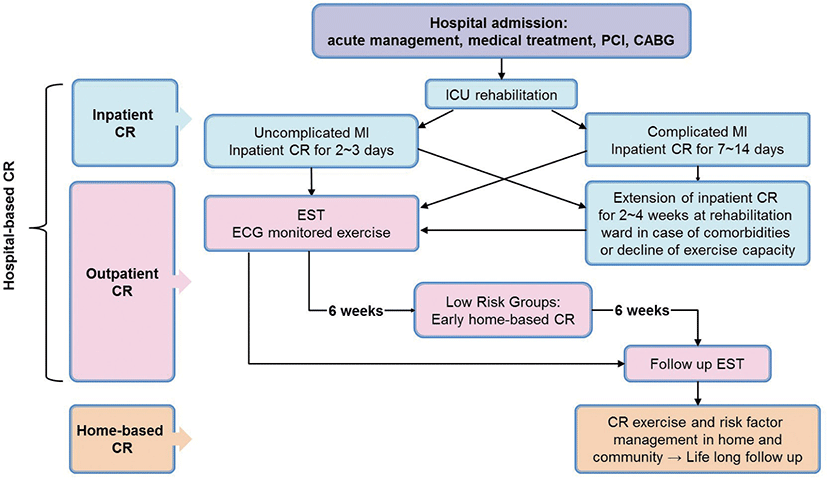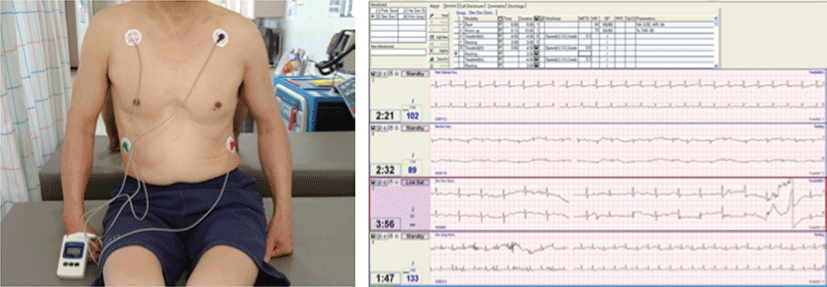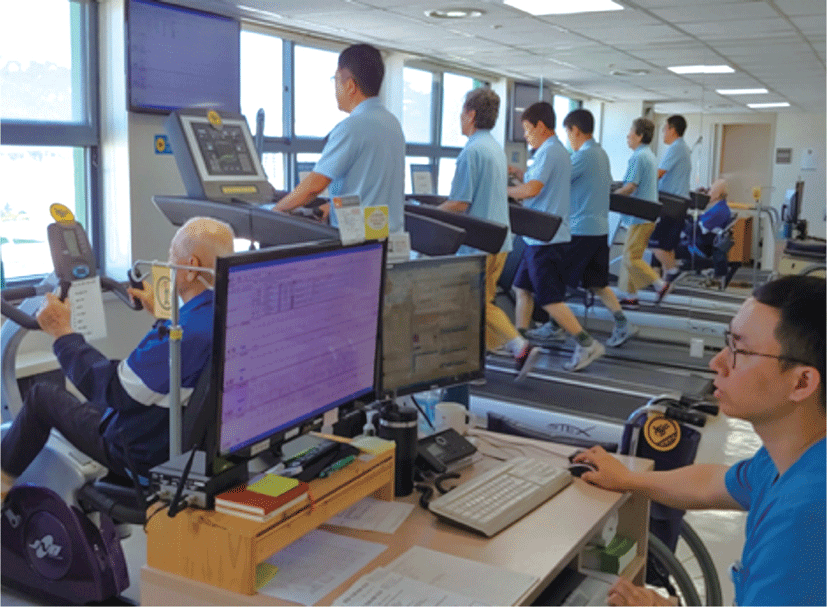서론
국내 심혈관질환 사망률은 지난 10년간 42.8%가 증가하여 2014년부터 대한민국 질병사인 2위로 부상하였다[1]. 2019년 통계청 자료에 의하면 인구 10만 명당 62.42명이 심혈관질환으로 사망하였는데 그 중 45%가 허혈성 심장병이었으며 급성 심근경색 및 심부전 관련 사망이 주를 이루고 있다[2]. 높은 사망률에는 처음 발병 당시의 사망뿐 아니라 첫 발병 이후 단기 및 장기 추적기간 동안의 재발 및 합병증에 의한 사망이 포함되며, 운동능력의 저하 및 삶의 질 감소라는 문제가 공존한다. 종종 심혈관질환은 급성 질환처럼 보이지만 실은 오랜 세월에 걸쳐 서서히 진행되어 온 만성질환(고혈압, 당뇨, 이상지질혈증, 동맥경화, 퇴행성 변화 등)에 기인하며 이는 퇴원 후에도 계속 진행하므로 만성질환 관리의 개념으로 평생 치료하고 관리해야 한다[3]. 일반적으로 심장재활은 심장질환의 급성기 치료(중환자실 집중치료, 약물치료, 관상동맥중재술 또는 관상동맥우회로 이식 수술, 심부전치료, 심박동기 및 제세동기 삽입, 심장이식 등)가 완료된 직후부터 시작되는 개별화된 운동치료 및 위험인자 관리 프로그램으로 모든 심혈관질환 환자에게 필수적으로 적용되어야 한다.
오늘날 심장재활은 세계 111개 국가에서 시행되고 있으며 그 효과와 안전성이 입증되어 있지만 심장재활 참여를 방해하는 여러 원인들로 인해 심장재활이 필요한 환자에서의 실제 심장재활 참여율은 미국과 같은 의료 선진국의 경우도 20-30% 수준에 불과하며 국내의 경우 보다 심각하게 비활성화되어 있다[4-6]. 본문에서는 심장재활의 필요성과 임상적용에 대한 개념적인 기술과 함께 심장재활의 국내 현실에 대해 언급하고자 한다.
본론
심장재활이 필요한 이유는 크게 두 가지로, 첫째 심폐지구력(cardiorespiratory fitness, CRF)을 향상시켜 정상적인 일상생활 및 사회활동이 가능하도록 회복시키는 것이고, 둘째 심혈관질환의 재발 및 이로 인한 재입원 및 조기사망을 감소시키는데 있다[7-9]. 이는 운동을 통한 다양한 기전의 심장 보호효과(cardio-protective effect)가 나타날 뿐 아니라, 심혈관질환의 여러 위험인자 관리가 보다 효과적으로 이루어지기 때문인 것으로 설명된다[8,9].
심장재활은 재입원율을 18% 감소시키고 모든 원인의 사망을 줄이거나 연기시키며 심혈관 사망률을 25% 감소시키는 것으로 보고되고 있으며, 심폐운동능력을 향상시키고 삶의 질을 회복시키는 등의 다양한 효과를 나타낸다(Table 1). 이러한 효과는 2기 심장재활 참여 세션 수가 많을수록 효과가 커지는 양-반응 상관성(dose-response relationship)을 보여 12세션 이상 참여한 경우 모든 원인의 사망이 42% 감소하였고 36세션을 모두 참여한 경우 반복 재관류술 시행을 35% 감소시켰다[10]. 또한 미국 메이요클리닉에서 심장재활에 참여한 5,641명의 관상동맥질환 환자에 대한 15년 추적연구 결과 심장재활 시작 1년 후 심폐지구력이 1 MET 향상할 때 마다 사망률이 25% 감소되는 효과가 나타났다[11].
심장재활 프로그램에는 1) 환자평가, 2) 식이요법, 3) 체중관리, 4) 혈압관리, 5) 혈중지질 관리, 6) 당뇨관리, 7) 금연, 8) 심리사회적 관리, 9) 신체 활동 상담, 10) 심장재활 운동치료에 대한 내용들이 모두 포함되어야 있어야 한다[12]. 국내 심장재활 건강보험 처방 코드는 심장재활 평가, 심장재활 치료, 심장재활 교육으로 구성되어 있으며 각기 건강보험 급여 청구가 가능하다. 심장재활을 위해서는 의사의 처방 및 감독이 절대적으로 필요하며 환자의 상태 및 보유 위험인자 여부에 따라 다양한 인력(물리치료사, 간호사, 임상영양사, 심리치료사, 작업치료사, 사회복지사 등)이 투입된다. 임상에서 시행되는 심장재활의 내용을 심장재활 건강보험 처방 코드 기준에 맞추어 정리하면 Table 2와 같다. 현 국민건강보험 기준에 의하면 심혈관질환으로 입원치료를 받고 퇴원 후 1년 이내에 시행된 심장재활 평가, 치료, 교육에 대한 수가를 청구할 수 있으며 심장재활 평가(심폐운동부하검사)는 퇴원 후 1년 이내 5회까지, 1년이 경과한 후로는 매년 1회씩 추적검사가 가능하고 심장재활 치료(모니터링 운동)는 36회까지만 보험적용이 된다. 다만 심장재활 교육 수가는 1회만 청구할 수 있으며 재발하거나 재입원하게 되더라도 반복 청구는 불가능하다. 2017년부터 심장재활 건강보험 적용이 가능해진 것은 다행스러운 일이나 대대적인 개선 작업이 필요하다.
심장재활 교육은 환자 스스로 자신의 병에 대해 잘 이해하고 자신에게 해당되는 위험인자들을 스스로 잘 관리할 수 있도록 유도하는 중요한 지침이 되는 만큼 Table 3의 내용들이 포함되어 있어야 한다[13]. 저자는 국내 심장재활 전문가들과 함께 국내 실정에 맞는 심장재활 시설, 장비, 인력에 대한 권고안을 발표한 바 있으며 처음 심장재활을 개설하고자 할 경우 어떤 기준에 따라 시설, 장비, 인력을 마련해야 할지를 설계하는 과정에 기초자료로 활용될 수 있을 것이다[14].
심장재활은 병원-심장재활(입원 심장재활 및 통원심장재활)과 지역사회-심장재활(또는 가정-심장재활)로 구분되며 이를 도식화한 주 임상경로(critical pathway)는 Fig. 1과 같다.

입원-심장재활은 환자의 심혈관 생명징후가 안정되고 흉통, 심근효소치 및 심전도 소견이 48시간 이상 안정되면 시작할 수 있다. 누운 자세가 앉은 자세보다 심근산소요구량을 더 높이므로 침상에서도 가능한 앉은 자세를 취하도록 한다. 호흡운동과 가벼운 체조를 시작으로 걷기운동을 시행한다. 입원 기간 중 1회라도 심전도 모니터링 운동(ECG monitoring exercise)을 경험하도록 하되 운동 중 협심증을 호소하거나, 운동 심박수가 안정 심박수에 비해 분당 20회 이상 증가 또는 10회 이상 떨어지거나, 새로운 부정맥이 나타나거나, 수축기 혈압이 기저치보다 10 mmHg 이상 떨어지거나, 비정상적인 혈압 상승(수축기 220 mmHg 이상, 이완기 110 mmHg 이상)이 나타날 경우 운동을 중단하고 주치의와 상의하도록 한다[15]. 일반적인 경우 입원 심장재활은 1일-7일 정도로 짧게 이루어지나 동반 합병증(뇌졸중, 근골격계 통증, 장기 침상안정에 의한 체력저하, 고령 등)으로 인해 퇴원 후 독립적인 일상생활동작이 어려운 일부 환자의 경우에는 입원 기간을 연장하거나 재입원하여 심장재활 및 해당 합병증에 대한 포괄적인 치료를 시행한다. 그리고 퇴원하기 전에 통원 심장재활의 필요성 및 방법에 대한 교육과 함께 통원 심장재활 외래 예약을 확인하여 통원 심장재활 일정이 미뤄지지 않도록 한다.
통원 심장재활의 시작은 입원 중 시술이나 약물치료를 받은 경우 퇴원 후 첫 1주 이내, 흉부 절개수술을 받은 경우 수술 4주 경과 시점이 좋으나, 의학적 또는 사회경제적 이유로 이 시기를 놓치게 되더라도 발병 후 3개월 내에는 시작하는 것이 좋다. 통원 심장재활 운동을 시작하기에 앞서 사전 병록 조사와 함께 의학적 평가 및 심폐운동부하(cardiopulmonary exercise stress)검사를 시행하여 운동관련 심장발작 위험도(Table 4)를 조사하고 이를 토대로 적정 수준의 운동처방 및 안전지침을 마련해야 한다[3,15-17].
심장발작 고 위험 군에 속한 환자는 운동 훈련 중 안전을 위해 12주간 병원에서 시행되는 심전도 모니터링(ECG monitoring)을 포함한 의료진의 감시하 운동(supervised-exercise) 프로그램(Fig. 2)에 참여하도록 한다[3,18].
운동 중 심전도 모니터링(ECG monitoring)은 4개의 심전도 전극을 부착하여 주로 lead II 신호를 관찰하며 송신기를 이용한 무선 심전도 모니터링 방법을 사용한다. 수신 채널 설치 개수에 따라 운동 중 심전도는 4-8명까지 동시 모니터링이 가능하다(Fig. 3).

중간위험 군에 속한 환자는 첫 4-6주간 병원에서의 모니터링 운동 프로그램에 참여하되 이 기간 동안 비정상 소견이 관찰되지 않을 경우 운동처방 및 교육내용(허용되는 운동의 종류, 운동강도, 스스로 모니터링 하는 방법, 적합한 운동자각지수)에 따라 남은 6-8주간 가정에서의 자가운동(home-based self-exercise) 프로그램으로 전환할 수 있다. 저 위험 군에 속한 환자는 1-2회 병원에서의 모니터링 운동 프로그램을 통해 운동 방법 및 주의 사항에 대한 교육을 받고 병원에서의 운동처방에 따라 스스로 잘 실천할 수 있다면 가정에서 자가운동(home-based self-exercise) 프로그램으로 시행할 수도 있다.
이 시기에 시행되는 운동은 주로 유산소운동(aerobic exercise)으로, 매회 5-10분간의 준비운동(warming up), 30-50분간의 본 운동(main exercise), 5-10분간의 정리운동(cool down)으로 총 1시간 동안 이루어지나 운동능력이 떨어져 있고 고령인 환자는 본 운동시간을 짧게 끊어 중간에 여러 번 휴식을 취하도록 한다. 운동강도는 심폐운동부하검사 결과에 따라 목표 심박수(target heart rate)로 정하되, 환자의 발병 시기 및 상태에 따라 여유 심박수(heart rate reserve)의 40-60% 강도로 시작하여 6-12주에 걸쳐 85-100%까지 점진적으로 증가시킨다. 운동 중 환자가 느끼는 힘든 정도를 표현하는 운동자각지수(rate of perceived exertion)로 운동 강도를 정하기도 하는데, 심박수가 일정치 않은 부정맥이나 베타차단제를 사용하는 경우 그리고 심장이식 수술을 받은 환자에서 유용하게 사용되며 일반적으로 운동자각지수 13-14의 느낌이 드는 강도로 운동하도록 한다. 운동 횟수는 주 3-4회가 적당하나 환자의 상태에 따라 조절한다. 운동훈련 중 이상 소견으로 운동을 중단해야 하는 경우는 Table 5와 같으며 이를 준수하지 않을 경우 심장발작 등의 심혈관 사고가 발생할 수 있으므로 반드시 지키도록 한다[15-17].
6-12주간의 통원-심장재활 기간이 경과되고 운동관련 심혈발작의 위험성이 현저히 감소된 안정된 상태가 유지되면 거주지역에서 자가운동과 위험인자관리를 스스로 실천하도록 하는 지역사회-심장재활(community-based cardiac rehabilitation)을 통해 유지기(maintenance phase)로 전환하게 된다. 통원-심장재활을 통해 심폐운동능력이 어느 정도 회복되었다고 해서 운동을 중단하게 되면 운동을 통해 얻은 수많은 유익들이 수 주 내에 소실되므로 환자 스스로 운동을 유지해 나갈 수 있도록 감독하고 격려해야 한다. 운동은 지역 헬스클럽을 이용하거나 가정이나 직장에 마련된 유산소 운동 장비를 활용할 수 있으며, 운동강도 조절 및 자기 감시(self-monitoring)의 개념을 잘 이해하고 조절할 수 있는 환자는 학교 운동장이나 워킹트랙, 등산로 등을 이용할 수 있다. 저항운동(resistive exercise)도 시행할 수 있으나 저항이 너무 커서 심근에 큰 부담을 주지 않도록 초기에는 탄력밴드를 이용하다가 점차 아령이나 웨이트를 사용하되 한번에 10-15회를 반복할 수 있는 정도의 무게범위 이내에서 시행되도록 교육한다[19]. 과도한 운동을 피할 수 있도록 목표 심박수, 운동 자각지수, 운동 중 호흡곤란 지수 등을 이용한 주기적인 운동처방의 변경이 필요하며 이를 토대로 일정한 강도의 운동을 계속 유지할 수 있도록 한다. 운동은 주2-3회, 한번에 1-1.5시간 정도가 적당하며 운동이 개인의 여가 및 취미활동의 일부가 되도록 한다. 파워워킹, 등산, 하이킹, 자전거, 배드민턴 등은 유지기 운동으로 적합하나, 보통 속도의 걷기는 운동강도가 낮아 적합하지 않다. 순간적인 심혈관계 부담이 큰 고강도 근력운동(역도, 팔 굽혀 펴기, 윗몸 일으키기, 팔씨름, 철봉, 씨름, 레슬링, 유도, 100미터 달리기, 마라톤 및 철인3종/5종 경기 등)은 피하도록 한다.
운동은 심혈관질환 환자에게 위험하다는 오래된 고정관념 때문에 아직도 적지 않은 의사들이 환자에게 운동을 권장하지 않는다. 그러나 이는 과거의 개념이고 심장재활의 안전성 확보를 위해 마련된 세가지 안전장치로 인해 심장재활 운동은 더 이상 위험한 치료로 분류되지 않는다. 심장재활의 첫 번째 안전장치는 금기증(Table 6)을 분명하게 구분하여 심장재활 평가 및 운동을 시행하지 않는 것이다[15].
두 번째 안전장치는 앞서 언급한 바와 같이 심장재활 운동을 시작하기에 앞서 병력 및 심폐운동 부하검사 결과에 따라 운동관련 심장발작 위험도 분류를 시행하는 것이다[16,17]. 위험도 분류는 효과적이고 안전한 운동처방을 위해 매우 중요한 작업이며 분류 결과에 따라 심장재활 운동훈련을 반드시 병원에서 시행해야 하는지 아니면 거주지역에서 스스로 시행해도 되는지를 정하는 중요한 기준이 된다. 세 번째 안전장치는 소위 ‘고 위험 군’에 속한 환자들의 운동훈련을 의료진의 감시 하에 시행하면서 운동훈련을 중단시켜야 상황(Table 5)이 나타나는지를 잘 관찰하면서 운동강도를 조절하는 모니터링 운동(monitoring exercise)을 통해 심장발작 발생을 사전에 차단함으로써 안전하고도 효과적인 운동이 이루어지도록 하는 것이다[15-18].
심장질환이 없는 인구집단에서 조깅, 수영, 테니스, 크로스컨트리 등의 활동 중 급성 심장마비가 발생할 확률은 375,000-888,000시간 당 1회이나 심장질환이 있는 환자의 경우 12,000-121,955시간 당 1회로, 심장질환이 있는 경우 운동 중 심장마비 발생률이 더 높은 것으로 알려져 있다[15]. 그러나 적절한 운동 프로그램은 심장질환 환자들의 질병관련 사망률을 의미 있게 감소시키므로 심장질환 환자들에게 적극적인 심장재활 운동훈련을 권고하는 것은 이득이 위해를 훨씬 상회하는 합리적인 결정이라 할 수 있다. 운동 중 지속적인 심전도 감시(continuous ECG monitoring)는 운동훈련 중 심장마비가 발생할 가능성을 현저하게 감소시킨다. 특히 2000년 이후의 연구결과들은 대부분 운동으로 인한 ‘심장발작 고 위험 군’을 사전에 선별하고 운동 중 심전도 모니터링을 시행하였으며 결과적으로 운동프로그램 중 심장마비 발생은 10만 운동시 간 당 1건, 심근경색증 발생은 30만 운동시간 당 1건, 사망률은 30-70만 운동시간 당 0-1건으로 극히 미미한 것으로 보고되었다[20]. 인제대학교 상계백병원 심장재활클리닉 보고에 의하면, 10년 간 975명의 환자를 대상으로 13,934시간(exercise hours)의 심장재활 운동훈련을 시행하는 동안 17건의 협심증 증 상, 31건의 심전도 이상, 10건의 협심증 증상을 동반한 심 전도 이상, 10건의 일시적인 혈압 불안정이 관찰되었으나, 급성 심근경색, 심장정지 및 사망 등의 주요심장사고(major adverse cardiac event, MACE)는 한 건도 발생하지 않았다[21].
심장재활은 현재 전 세계적으로 111개 국가에서 시행되고 있고 이미 높은 근거수준의 심장재활 임상진료지침을 발표하여 심장재활 프로그램의 시행을 강하게 권고하고 있으며[3,13], 국내에도 보건산업진흥원 보건의료기술연구 개발사업 지원으로 한국형 심장재활 임상진료지침이 개발된 바 있어다[22]. 그러나 심장재활 참여를 방해하는 여러 요인들로 인해 실제 심장재활 참여율은 의료 선진국조차도 30-40% 정도로 아직 낮은 실정이다[4,23]. 2017년 7월부터 2018년 6월까지 1년간의 건강보험 빅데이터 분석결과, 권역심뇌혈관질환센터를 포함한 전국 대학병원 및 심혈관 전문병원들 중 심장재활 수가 청구는 26개 병원에서만 이루어졌고 급성 심근경색 후 심장재활 참여율은 의료 선진국에 훨씬 못 미치는 1.5% 수준에 불과하였다[24].
저자는 질병관리청 국립보건연구원 과제 「심장재활의 병원 및 지역사회 이행제고 전략개발 연구」를 수행하고 있으며 2020년 하반기 전국 실태조사 결과, 권역심뇌혈관질환센터를 포함한 전국 164개 심혈관전문병원(관상동맥중재술 시행 병원)중 47개(28.7%) 병원에만 심장재활 프로그램이 개설되어 있었으며 권역 별 연간 심장질환 환자 수 통계에 비추어 볼 때 권역 간 불균형이 존재하였다(Table 7).
심장재활 개설은 병원의 규모와는 별개로 병원마다 사용하는 전략과 활성화 의지에 따라 활성화되어 있는 병원도 있지만 그렇지 않은 곳이 많았으며 심장재활 개설병원으로 보고된 47개 병원 중 8개 병원은 아직 실질적인 심장재활이 이루어지지 않고 있고 나머지 39개 병원 중에도 심장재활이 아주 활발하게 이루어지는 곳은 많지 않았다. 심장재활 개설이 어려운 이유로는 심장재활 인력, 예산, 공간, 장비의 부족에 대한 의견이 많았고 심장재활 보험수가가 너무 낮아 투자 대비 수익을 창출하기 어려운 경영상 마이너스 구조를 갖고 있어 시설 투자가 꺼려진다는 의견과 현 심장재활 급여 및 수가 기준은 심장재활 의뢰 의지를 떨어뜨린다는 의견이 많았다.
심혈관질환은 퇴원 후에도 만성 전신혈관질환 관리의 개념을 갖고 평생 치료하고 관리해야 하므로 환자들은 병원에서의 치료뿐 아니라 지역사회에서의 만성질환 관리가 지속적으로 유지되어야 한다. 그러나 국내 지역 민간/공공 의료기관 및 공공 건강관리기관에서 지역사회-심장재활을 담당할 만한 여건이 조성되어 있는지를 조사한 결과, 민간 의료기관(종합병원 및 재활요양병원) 및 공공보건의료기관(의료원, 보건의료원, 보건소) 모두 금연 및 건강관리 상담은 가능하나 심장재활 운동 관련 시설, 장비, 인력 여건이 마련되어 있지 않았고, 공공건강관리기관(복지관, 국민체육센터, 건강생활지원센터 등)의 경우 심장재활에 대한 인식 및 운영 인력이 전무한 상태로 조사되었다.
이상의 결과들로 보아, 심장재활이 국내 병원 및 지역사회에서 적극적으로 시행될 수 있으려면 우선 가능한 많은 심혈관질환 전문병원에 심장재활이 개설되어야 하며 이를 위한 구체적인 로드맵과 지원 전략이 마련되어야 한다. 뿐만 아니라 환자들의 심장재활 참여율을 높이기 위한 다양한 전략들, 예를 들면 의료진 및 환자 대상 교육을 통해 심장재활의 중요성을 충분히 이해할 수 있도록 알리고, 자동협진시스템(automatic referral system)을 구축하여 급성기 치료가 완료되는 대로 심장재활이 바로 시작될 수 있도록 하며 심장재활에 필요한 환자 부담금은 줄이되 심장재활을 시행하는 병원에는 어느 정도의 수익이 보존될 수 있도록 적정 수준의 건강보험 수가 개선(수가는 올리되 환자 부담률은 낮추는) 등이 필요하다[4,25]. 또한 병원-심장재활에 참여하기에는 접근성이 떨어지는 환자들을 위하여 보다 유연한 병원 심장재활 환경의 제공 및 가정-심장재활의 활성화가 필요하며 디지털 헬스케어 기술을 이용한 스마트 심장재활의 빠른 임상적용이 요구된다. 지역사회-심장재활을 위해서는 민간의료 및 공공의료/건강관리기관의 이해와 협조가 필요하며 이를 위한 보건 당국의 정책적 변화가 필요하다.
심장재활의 활성화는 의료기관의 노력만으로는 불가능하며, 정부 차원의 정책적 지원과 예산 집행이 뒤따라야만 한다. 심장재활이 활성화되면 심장혈관질환 환자들의 예후가 개선되므로 재발에 따른 의료비가 절감되고 생산연령의 직장 복귀율이 높아져 사회경제적 이득이 커질 뿐 아니라 이로 인한 국가의 비용부담이 줄어들 것이기 때문이다. 이는 심뇌혈관질환예방관리법 재정의 근본 목적과 부합되는 것이며 국가 건강관리 전략으로 추진해야 할 중요한 과제라고 할 수 있다.
결론
심장재활은 심혈관질환 치료의 연속선 상에 놓여 있는 심혈관질환 관리에 필수적인 요소이다. 심장재활은 그 효과와 안정성이 이미 확립되어 있으며 높은 근거수준 및 권고강도로 전 세계 111개 국가에서 시행되고 있다. 그러나 심장재활 활성화를 저해하는 많은 방해요인들로 인해 심장재활 적응증에 속한 환자들의 실제 심장재활 참여율은 매우 낮은 편이며 특히 우리나라의 경우 급성 심근경색 환자의 심장재활 참여율이 1.5% 수준 밖에 안될 정도로 매우 심각하게 비활성화되어 있다. 심장재활은 심폐지구력 및 삶의 질을 향상시킬 뿐 아니라 재발, 재입원, 재시술 및 조기 사망을 의미 있게 감소시킨다. 심장재활 프로그램에는 환자평가, 식이요법, 체중관리, 혈압관리, 혈중지질 관리, 당뇨관리, 금연 교육, 심리사회적 관리, 신체 활동 상담, 및 심장재활 운동치료에 대한 핵심 내용들이 모두 포함되어 있어야 한다. 심장재활 운동은 안전성의 확보가 중요하며 이를 위해 금기증은 절대 포함시키지 말아야 하고 운동훈련을 시행하기에 앞서 세심한 진료기록 검토 및 심폐운동부하검사를 통해 운동관련 심장발작 위험도 분류를 하여 ‘고 위험 군’에 속한 환자는 병원-심장재활에 참여하도록 해야 한다. 그리고 심전도 모니터링 운동 중 운동 중단 기준을 철저하게 준수함으로써 안전한 심장재활 운동이 이루어지도록 해야 한다. 현재 국내 164개 심장혈관질환전문병원 중 심장재활이 개설된 병원은 47개로 전체의 28%에 불과하다. 국내 심장재활이 활성화되려면 심장재활을 시행하는 병원이 가능한 더 많이 생겨야 하고 심장재활의 필요성에 대한 의료진 및 환자 대상 교육, 홍보가 대대적으로 이루어져야 하며, 보다 체계적인 심장재활 협진을 통해 심혈관질환으로 입원한 환자들의 대부분이 심장재활 프로그램에 의뢰되도록 해야 한다. 뿐만 아니라 통원 심장재활 참여율을 높이기 위하여 병원 중심이 아닌 환자 중심의 심장재활 일정이 제공하고 운동관련 심장발작 위험도가 높지 않은 환자들을 위한 가정-심장재활 및 디지털 헬스케어 개념의 스마트-심장재활의 적극적인 활용이 필요하다. 또한 심장재활의 환자 비용 부담을 줄이기 위한 보험제도의 개선 역시 필요하다. 국내 심장재활의 활성화는 의료기관 및 관련 의료진의 노력 만으로는 성과를 거두기 어렵다. 심장재활은 공익성이 매우 강한 의료분야이며 최대 수혜자는 국가이므로 보건복지부, 질병관리청, 건강보험공단, 심평원 등 정부 관련 부처의 이해와 협조 그리고 과감한 정책적 지원이 이루어져야 하겠다.








